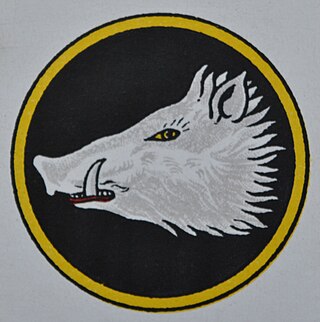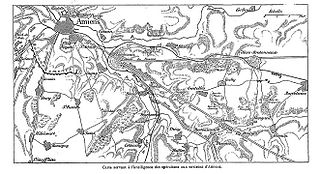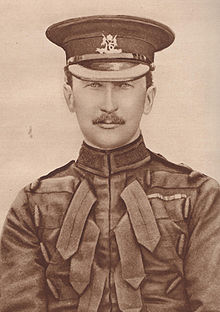
The Third Battle of Ypres, also known as the Battle of Passchendaele, was a campaign of the First World War, fought by the Allies against the German Empire. The battle took place on the Western Front, from July to November 1917, for control of the ridges south and east of the Belgian city of Ypres in West Flanders, as part of a strategy decided by the Allies at conferences in November 1916 and May 1917. Passchendaele lies on the last ridge east of Ypres, 5 mi (8 km) from Roulers, a junction of the Bruges-(Brugge)-to-Kortrijk railway. The station at Roulers was on the main supply route of the German 4th Army. Once Passchendaele Ridge had been captured, the Allied advance was to continue to a line from Thourout to Couckelaere (Koekelare).

The Battle of the Somme, also known as the Somme offensive, was a battle of the First World War fought by the armies of the British Empire and the French Third Republic against the German Empire. It took place between 1 July and 18 November 1916 on both sides of the upper reaches of the river Somme in France. The battle was intended to hasten a victory for the Allies. More than three million men fought in the battle, of whom more than one million were either wounded or killed, making it one of the deadliest battles in all of human history.
The British Expeditionary Force (BEF) was the six-divisions the British Army sent to the Western Front during the First World War. Planning for a British Expeditionary Force began with the 1906–1912 Haldane Reforms of the British Army carried out by the Secretary of State for War Richard Haldane following the Second Boer War (1899–1902).

The Australian Corps was a World War I army corps that contained all five Australian infantry divisions serving on the Western Front. It was the largest corps fielded by the British Empire in France. At its peak the Australian Corps numbered 109,881 men. By 1918 the headquarters consisted of more than 300 personnel of all ranks, including senior staff officers, as well as supporting personnel such as clerks, drivers and batmen. Formed on 1 November 1917, the corps replaced I Anzac Corps while II Anzac Corps, which contained the New Zealand Division, became the British XXII Corps on 31 December. While its structure varied, Australian Corps usually included 4–5 infantry divisions, corps artillery and heavy artillery, a corps flying squadron and captive balloon sections, anti-aircraft batteries, corps engineers, corps mounted troops, ordnance workshops, medical and dental units, transport, salvage and an employment company.

The Reserve Army was a field army of the British Army and part of the British Expeditionary Force during the First World War. On 1 April 1916, Lieutenant-General Sir Hubert Gough was moved from the command of I Corps and took over the Reserve Corps, which in June before the Battle of the Somme, was expanded and renamed Reserve Army. The army fought on the northern flank of the Fourth Army during the battle and became the Fifth Army on 30 October.

The first day on the Somme, 1 July 1916, was the beginning of the Battle of Albert (1–13 July), the name given by the British to the first two weeks of the 141 days of the Battle of the Somme in the First World War. Nine corps of the French Sixth Army and the British Fourth and Third armies attacked the German 2nd Army from Foucaucourt south of the Somme, northwards across the Somme and the Ancre to Serre and at Gommecourt, 2 mi (3.2 km) beyond, in the Third Army area. The objective of the attack was to capture the German first and second defensive positions from Serre south to the Albert–Bapaume road and the first position from the road south to Foucaucourt.

The Fourth Army was a field army that formed part of the British Expeditionary Force during the First World War. The Fourth Army was formed on 5 February 1916 under the command of General Sir Henry Rawlinson to carry out the main British contribution to the Battle of the Somme.

The History of the Great War Based on Official Documents by Direction of the Committee of Imperial Defence is a series of 109 volumes, concerning the war effort of the British state during the First World War. It was produced by the Historical Section of the Committee of Imperial Defence from 1915 to 1949; after 1919 Brigadier-General Sir James Edmonds was Director. Edmonds wrote many of the army volumes and influenced the choice of historians for the navy, air force, medical and veterinary volumes. Work had begun on the series in 1915 and in 1920, the first volumes of Naval Operations and Seaborne Trade, were published. The first "army" publication, Military Operations: France and Belgium 1914 Part I and a separate map case were published in 1922 and the final volume, The Occupation of Constantinople was published in 2010.

The Battle of Pozières took place in northern France around the village of Pozières, during the Battle of the Somme. The costly fighting ended with the British in possession of the plateau north and east of the village, in a position to menace the German bastion of Thiepval from the rear. The Australian official historian Charles Bean wrote that Pozières ridge "is more densely sown with Australian sacrifice than any other place on earth".

The Fifth Battle of Ypres, also called the Advance in Flanders and the Battle of the Peaks of Flanders is an informal name used to identify a series of World War I battles in northern France and southern Belgium (Flanders) from late September to October 1918.

The Battle of the Boar's Head was an attack on 30 June 1916 at Richebourg-l'Avoué in France, during the First World War. Troops of the 39th Division, XI Corps in the First Army of the British Expeditionary Force (BEF), advanced to capture the Boar's Head, a salient held by the German 6th Army. Two battalions of the 116th Brigade, with one battalion forming carrying parties, attacked the German front position before dawn on 30 June. The British took and held the German front line trench and the second trench for several hours, before retiring to their lines having lost 850–1,366 casualties.

The First Battle of Villers-Bretonneux, took place during Operation Michael, part of the German spring offensive on the Western Front. The offensive began against the British Fifth Army and the Third Army on the Somme and pushed back the British and French reinforcements on the north side of the Somme. The capture of Villers-Bretonneux, close to Amiens, a strategically important road- and rail-junction, would have brought the Germans within artillery-range. In late March, Australian troops were brought south from Belgium as reinforcements to help shore up the line and in early April the Germans launched an attack to capture Villers-Bretonneux. After a determined defence by British and Australian troops, the attackers were close to success until a counter-attack by the 9th Australian Infantry Brigade and by British troops, late in the afternoon of 4 April, restored the line and halted the German advance on Amiens.

Operation Alberich was the code name of a German military operation in France during the First World War. Two salients had been formed during the Battle of the Somme in 1916 between Arras and Saint-Quentin and from Saint-Quentin to Noyon. Alberich was planned as a strategic withdrawal to new positions on the shorter and more easily defended Hindenburg Line. General Erich Ludendorff was reluctant to order the withdrawal and hesitated until the last moment.

This is the order of battle for the Battle of the Somme. The Battle of the Somme was an offensive fought on the Western Front during World War I from 1 July to 18 November 1916 as one of the greatest engagements of the war. It was fought between French, British and Dominion forces and the German Empire in the Somme River valley and vicinity in northern France.

VI Corps was an army corps of the British Army in the First World War. It was first organised in June 1915 and fought throughout on the Western Front. It was briefly reformed during the Second World War to command forces based in Northern Ireland, but was reorganized as British Forces in Ireland one month later.

The Battle of Courtrai was one of a series of offensives in northern France and southern Belgium that took place in late September and October 1918.

Operation Michael was a major German military offensive during the First World War that began the German Spring Offensive on 21 March 1918. It was launched from the Hindenburg Line, in the vicinity of Saint-Quentin, France. Its goal was to break through the Allied (Entente) lines and advance in a north-westerly direction to seize the Channel Ports, which supplied the British Expeditionary Force (BEF), and to drive the BEF into the sea. Two days later General Erich Ludendorff, the chief of the German General Staff, adjusted his plan and pushed for an offensive due west, along the whole of the British front north of the River Somme. This was designed to first separate the French and British Armies before continuing with the original concept of pushing the BEF into the sea. The offensive ended at Villers-Bretonneux, to the east of the Allied communications centre at Amiens, where the Allies managed to halt the German advance; the German Army had suffered many casualties and was unable to maintain supplies to the advancing troops.

The Capture of Lesbœufs [25 September 1916] was a tactical incident in the Battle of the Somme. Lesbœufs was a village on the D 74 between Gueudecourt and Morval, about 30 miles (48 km) north-east of Amiens; Le Transloy lies to the north-west and Bapaume is to the north. French Territorials fought the II Bavarian Corps on the north bank of the Somme in late September 1914, after which the front line moved west past the village. Little military activity occurred round the village until the beginning of the Battle of the Somme, when German troops passed through the village in the first weeks of the battle. During the Battle of Flers–Courcelette (15–22 September), advances by the right flank corps of the British Fourth Army, brought the front line forward to the Gallwitz Riegel trenches west of Lesbœufs but exhaustion prevented the British from reaching their third objective, a line east of Morval, Lesbœufs and Gueudecourt.

The Capture of Eaucourt l'Abbaye was a tactical incident during the Battle of the Somme. Eaucourt is about 16 mi (26 km) south of Arras, at the junction of the D 929 and the D 10E roads. Eaucourt l'Abbaye (Eaucourt) is north-west of Martinpuich, south-east of Le Sars, south of the Butte de Warlencourt west of Gueudecourt and north-west of Flers. Eaucourt was a group of farm buildings in an enclosure built on the site of an Augustinian abbey, on a side road from Le Sars off the main Albert–Bapaume highway. Destremont Farm to the south-west of Le Sars and a derelict quarry south of Eaucourt had been fortified by the Germans.

The Hohenzollern Redoubt was a strongpoint of the German 6th Army on the Western Front during the First World War, at Auchy-les-Mines near Loos-en-Gohelle in the Nord-Pas-de-Calais region of France. Named after the House of Hohenzollern, the redoubt was fought for by German and British forces. Engagements took place from the Battle of Loos (25 September – 14 October 1915) to the beginning of the Battle of the Somme on 1 July 1916, including the action of the Hohenzollern Redoubt in 1915 and the British Attack at the Hohenzollern Redoubt from 2 to 18 March 1916.
















